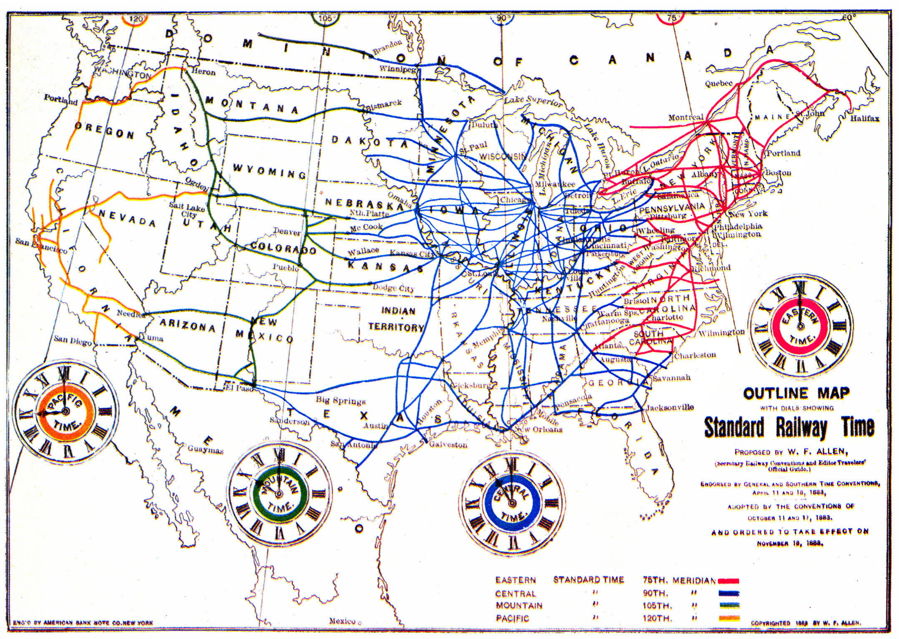
The following article by Charles Hartley originally appeared in The Courier-Journal on 2 Nov 2014. It is archived here with additional information for your reading enjoyment.
Did you set your clocks back a hour? If not, it's earlier than you think.
This annual ritual of "springing forward" and "falling back" seems like it's been with us forever, but in fact its practice began only sporadically less than a century ago in Europe. It spread to the United States in 1918 during World War I, but was soon pretty much abandoned a year later as impractical. In those days, America was still largely a farming society whose members didn't need a clock to tell them it was time to get up when the rooster took care of that chore. Even in the cities, few businesses stayed open late in the evening to take advantage of an extra hour's daylight.
Our next experiment with DST occurred during World War II with "War Time," when the clocks were set forward year-round. Following the war, DST practices varied in different parts of the country, depending on local preferences, and it was not until 1966 that Congress passed the Uniform Time Act which specified that DST would begin the last Sunday in April and end the last Sunday in October.
Since then, the starting and ending days have changed a bit. Most recently, with the passage of Energy Policy Act in 2007, DST starts the second Sunday in March and ends today.
But before daylight saving time could be established, folks needed to figure out just what time it was.
During and following the Civil War many folks did not bother to carry a timepiece, and even those who did were hard-pressed to keep accurate time since there was no such thing as standard time. Each community kept its own time, often at the courthouse or at a local jeweler's business.
For example, in 1866, according the the federal excise tax records, there were just 14 men in Bullitt County who owned gold pocket watches; six of them each owned two. They included Dr. Samuel McKay; Samuel Carothers and James Stallings, both distillers; William Colbin, a merchant; two lawyers, John D. Bryan and Abram H. Field; and several successful farmers including Solomon Brooks, James English, William Hays, Charles Lee, James Moore, and Westley Phelps. While there were certainly more lesser-quality timepieces in the county at that time, it is doubtful how many of them agreed with one another.
And this was the case across the nation with each community deciding for itself just what time it was. This became a real problem with the coming of the railroad. By 1880 the tracks had spread across the nation, and making accurate train schedules was a nightmare.
It was 1869 when the Rev. Dr. Charles Ferdinand Dowd, the headmaster of Temple Grove Seminary in Saratoga Springs, New York, came up with his idea of dividing the nation into standard time zones. The next year he submitted his plan, complete with a map of the country, to the railway managers at a convention; but it wasn't until November 18, 1883 that his plan for four time zones was adopted by the railroad industry.

The next year, President Chester A. Arthur convened the Washington Meridian Conference where it was agreed to establish time zones around the world, and to recognize the meridian passing through Greenwich, England as the Prime Meridian.
Unfortunately for Professor Dowd, he was struck and killed by a locomotive, November 12, 1904. No doubt the train was running behind time.
There continued to be bumps in the road, with some American communities resisting the standards, but, by and large, Americans enthusiastically accepted them.
Today we measure time down to the millisecond and brag about our atomic clocks, but not so long ago time was a much more leisurely concept. So, if it's not too cloudy today, check out that backyard sundial and see if it is time for lunch yet.

Copyright 2014 by Charles Hartley, Shepherdsville KY. All rights are reserved. No part of the content of this page may be included in any format in any place without the written permission of the copyright holder.
The Bullitt County History Museum, a service of the Bullitt County Genealogical Society, is located in the county courthouse at 300 South Buckman Street (Highway 61) in Shepherdsville, Kentucky. The museum, along with its research room, is open 10 a.m. to 4 p.m. Monday through Friday. Saturday appointments are available by calling 502-921-0161 during our regular weekday hours. Admission is free. The museum, as part of the Bullitt County Genealogical Society, is a 501(c)3 tax exempt organization and is classified as a 509(a)2 public charity. Contributions and bequests are deductible under section 2055, 2106, or 2522 of the Internal Revenue Code. Page last modified: 13 Jan 2024 . Page URL: bullittcountyhistory.org/memories/time.html